Rockloving Erigeron
(Erigeron petrophilus)
Rockloving Erigeron (Erigeron petrophilus)
/
/

Matt Berger
CC BY 4.0
Image By:
Matt Berger
Recorded By:
Copyright:
CC BY 4.0
Copyright Notice:
Photo by: Matt Berger | License Type: CC BY 4.0 | License URL: http://creativecommons.org/licenses/by/4.0/ | Rights Holder: Matt Berger | Publisher: iNaturalist | Date Created: 2018-07-21T17:36:52-07:00 |























Estimated Native Range
Climate Requirements for Mito, Japan
| This Plant | Your Site | Plant Suitability for Your Location | ||
|---|---|---|---|---|
| • Precipitation | 16" - 78" | 56" | Aquatic | Aquatic |
| • High Temp. | 68°F - 92°F | 85°F | Your summer temperatures are normal for this plant. | Excellent |
| • Low Temp. | 14°F - 41°F | 27°F | Your winter temperatures are normal for this plant | Excellent |
This plant may not grow well at your location - your precipitation is too high.
Summary
Erigeron petrophilus, commonly known as rockloving erigeron or cliff fleabane, is a perennial herb native to rocky outcrops and cliff faces within mixed coniferous forests in California and southwestern Oregon, often found on serpentine soils. It typically forms clumps reaching up to 2 feet in height and width. The plant has a woody caudex from which many hairy, glandular stems arise, and it is adorned with narrow, oblong leaves that cluster at the base and along the stems. The inflorescence consists of several small flower heads, each with yellow disc florets but no ray florets, and each head is just over a centimeter wide. The flowers bloom in late spring to early summer and are attractive to a variety of pollinators.
Rockloving erigeron is valued for its ability to thrive in challenging conditions, such as rocky or serpentine soils, where other plants may struggle. It is often used in rock gardens, native plant landscapes, and restoration projects for its adaptability and low maintenance. This species prefers well-drained soils and can tolerate drought once established, making it suitable for xeriscaping. It requires full sun to part shade and is generally free from major pests and diseases. However, it may be susceptible to root rot if overwatered or planted in poorly drained soils.CC BY-SA 4.0
Rockloving erigeron is valued for its ability to thrive in challenging conditions, such as rocky or serpentine soils, where other plants may struggle. It is often used in rock gardens, native plant landscapes, and restoration projects for its adaptability and low maintenance. This species prefers well-drained soils and can tolerate drought once established, making it suitable for xeriscaping. It requires full sun to part shade and is generally free from major pests and diseases. However, it may be susceptible to root rot if overwatered or planted in poorly drained soils.CC BY-SA 4.0
Plant Description
- Plant Type: Herb
- Height: 0.5-1.5 feet
- Width: 0.5-1.5 feet
- Growth Rate: Moderate
- Flower Color: White, Yellow
- Flowering Season: Spring, Summer, Fall
- Leaf Retention: Deciduous
Growth Requirements
- Sun: Full Sun, Part Shade
- Water: Low
- Drainage: Fast, Medium
Common Uses
Border Plant, Low Maintenance, Rock Garden
Natural Habitat
Rocky outcrops and cliff faces within mixed coniferous forests
Other Names
Common Names: Rockloving Daisy, Rock Fleabane
Scientific Names: Erigeron petrophilus
GBIF Accepted Name: Erigeron petrophilus